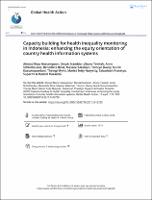| dc.description.abstract | Background: Inequalities in health represent a major problem in many countries, including Indonesia. Addressing health inequality is a central component of the Sustainable Development Goals and a priority of the World Health Organization (WHO). WHO provides technical support for health inequality monitoring among its member states. Following a capacity-building workshop in the WHO South-East Asia Region in 2014, Indonesia expressed interest in incorporating healthinequality monitoring into its national health information system. Objectives: This article details the capacity-building process for national health inequality monitoring in Indonesia, discusses successes and challenges, and how this process may be adapted and implemented in other countries/settings. Methods: We outline key capacity-building activities undertaken between April 2016 and December 2017 in Indonesia and present the four key outcomes of this process. Results: The capacity-building process entailed a series of workshops, meetings, activities, and processes undertaken between April 2016 and December 2017. At each stage, a range of stakeholders with access to the relevant data and capacity for data analysis, interpretation and reporting was engaged with, under the stewardship of state agencies. Key steps to strengthening health inequality monitoring included capacity building in (1) identification of the health topics/ areas of interest, (2) mapping data sources and identifying gaps, (3) conducting equity analyses using raw datasets, and (4) interpreting and reporting inequality results. As a result, Indonesia developed its first national report on the state of health inequality. A number of peer-reviewed manuscripts on various aspects of health inequality in Indonesia have also been developed. Conclusions: The capacity-building process undertaken in Indonesia is designed to be adaptable to other contexts. Capacity building for health inequality monitoring among countries is a critical step for strengthening equity-oriented national health information systems and eventually tackling health inequities. | |

